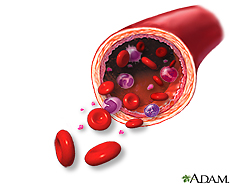Bleeding Disorders Update
MedlinePlus sent this bulletin at 04/20/2016 01:10 PM EDTNew on the MedlinePlus Bleeding Disorders page:

04/13/2016 02:39 PM EDT

Source: National Library of Medicine - 

04/13/2016 02:39 PM EDT

Source: National Library of Medicine - 

04/13/2016 02:39 PM EDT

Source: National Library of Medicine - 

04/13/2016 02:39 PM EDT

Source: National Library of Medicine - 

04/13/2016 02:39 PM EDT

Source: National Library of Medicine - 

04/13/2016 02:39 PM EDT

Source: National Library of Medicine - 

04/13/2016 02:39 PM EDT

Source: National Library of Medicine - 

04/13/2016 02:39 PM EDT

Source: National Library of Medicine - 

04/13/2016 02:39 PM EDT

Source: National Library of Medicine - 

National Institutes of Health
Normally, if you get hurt, your body forms a blood clot to stop the bleeding. For blood to clot, your body needs cells called platelets and proteins known as clotting factors. If you have a bleeding disorder, you either do not have enough platelets or clotting factors or they don't work the way they should.
Bleeding disorders can be the result of other diseases, such as severe liver disease. They can also be inherited. Hemophilia is an inherited bleeding disorder. Bleeding disorders can also be a side effect of medicines.
- What Are the Signs and Symptoms of Disseminated Intravascular Coagulation?
 (National Heart, Lung, and Blood Institute)
(National Heart, Lung, and Blood Institute)
- Coagulation Factors Test (American Association for Clinical Chemistry)
- D-dimer Test (American Association for Clinical Chemistry)
- Factor V Leiden Mutation and PT 20210 Mutation Test (American Association for Clinical Chemistry)
- Fibrinogen Test (American Association for Clinical Chemistry)
- How Is Disseminated Intravascular Coagulation Diagnosed?
 (National Heart, Lung, and Blood Institute)
(National Heart, Lung, and Blood Institute) - Platelet Count (American Association for Clinical Chemistry)
- PT and INR Test (American Association for Clinical Chemistry)
- PTT Test (American Association for Clinical Chemistry)
- Thrombin Time (American Association for Clinical Chemistry)
- How Is Disseminated Intravascular Coagulation Treated?
 (National Heart, Lung, and Blood Institute)
(National Heart, Lung, and Blood Institute) - MedlinePlus: Blood Thinners
 (National Library of Medicine)Available in Spanish
(National Library of Medicine)Available in Spanish - Treatment Options (World Federation of Hemophilia)
- Living with Disseminated Intravascular Coagulation
 (National Heart, Lung, and Blood Institute)
(National Heart, Lung, and Blood Institute) - What Is a Blood Transfusion?
 (National Heart, Lung, and Blood Institute)
(National Heart, Lung, and Blood Institute)
- Disseminated Intravascular Coagulation
 (National Heart, Lung, and Blood Institute)
(National Heart, Lung, and Blood Institute) - What Are Rare Clotting Factor Deficiencies? (World Federation of Hemophilia)
- What Is Combined Deficiency of Vitamin K-Dependent Clotting Factors? (World Federation of Hemophilia)Available in Spanish
- Genetics Home Reference: acute promyelocytic leukemia
 (National Library of Medicine)
(National Library of Medicine) - Genetics Home Reference: congenital afibrinogenemia
 (National Library of Medicine)
(National Library of Medicine) - Genetics Home Reference: factor V deficiency
 (National Library of Medicine)
(National Library of Medicine) - Genetics Home Reference: factor X deficiency
 (National Library of Medicine)
(National Library of Medicine) - Genetics Home Reference: factor XIII deficiency
 (National Library of Medicine)
(National Library of Medicine) - Genetics Home Reference: gray platelet syndrome
 (National Library of Medicine)
(National Library of Medicine) - Genetics Home Reference: Noonan syndrome
 (National Library of Medicine)
(National Library of Medicine) - Genetics Home Reference: prekallikrein deficiency
 (National Library of Medicine)
(National Library of Medicine) - Genetics Home Reference: prothrombin deficiency
 (National Library of Medicine)
(National Library of Medicine) - Genetics Home Reference: Stormorken syndrome
 (National Library of Medicine)
(National Library of Medicine) - Genetics Home Reference: thrombocytopenia-absent radius syndrome
 (National Library of Medicine)
(National Library of Medicine) - Genetics Home Reference: Wiskott-Aldrich syndrome
 (National Library of Medicine)
(National Library of Medicine)
- Easy Bleeding (DSHI Systems)
- Blood clotting
 - EncyclopediaAvailable in Spanish
- EncyclopediaAvailable in Spanish
- ClinicalTrials.gov: Blood Coagulation Disorders
 (National Institutes of Health)
(National Institutes of Health)
- Bleeding and Clotting Disorders Glossary (National Hemophilia Foundation)
- Centers for Disease Control and Prevention Available in Spanish
- Find a Hematologist (American Society of Hematology)
- National Heart, Lung, and Blood Institute

- Blood (For Parents) (Nemours Foundation)Available in Spanish
- Blood Transfusions (Nemours Foundation)Available in Spanish
- Bleeding Disorders (Department of Health and Human Services, Office on Women's Health)
- Bleeding Disorders in Women (Centers for Disease Control and Prevention)Available in Spanish
- What Should You Know about Blood Disorders in Women? (Centers for Disease Control and Prevention)
- Bleeding disorders Available in Spanish
- Bleeding time Available in Spanish
- Disseminated intravascular coagulation (DIC) Available in Spanish
- Hemorrhagic disease of the newborn Available in Spanish
- Osler-Weber-Rendu syndrome Available in Spanish
- Partial thromboplastin time (PTT) Available in Spanish
- Prothrombin time (PT) Available in Spanish























.png)











No hay comentarios:
Publicar un comentario